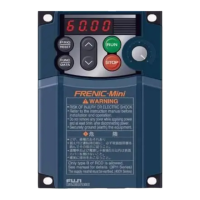6.3 Peripheral Equipment
6-13
Chap. 6 SELECTING PERIPHERAL EQUIPMENT
6.3 Peripheral Equipment
[ 1 ] Molded case circuit breaker (MCCB), earth leakage circuit breaker
(ELCB) and magnetic contactor (MC)
[ 1.1 ] Functional overview
MCCBs and ELCBs*
*With overcurrent protection
Molded Case Circuit Breakers (MCCBs) are designed to protect the power circuits between the power
supply and inverter's main circuit terminals (L1/R, L2/S and L3/T for three phase, or L1/L and L2/N
for single-phase power source) from overload or short-circuit, which in turn prevents secondary
accidents caused by the inverter malfunctioning.
Earth Leakage Circuit Breakers (ELCBs) function in the same way as MCCBs.
Built-in overcurrent/overload protective functions protect the inverter itself from failures related to its
input/output lines.
MCs
An MC can be used at both the power input and output sides of the inverter. At each side, the MC
works as described below. When inserted in the output circuit of the inverter, the MC can also switch
the motor drive power source between the inverter output and commercial power lines.
At the power source side
Insert an MC in the power source side of the inverter in order to:
(1) Forcibly cut off the inverter from the power source (generally, commercial/factory power lines)
with the protective function built into the inverter, or with the external signal input.
(2) Stop the inverter operation in an emergency when the inverter cannot interpret the stop
command due to internal/external circuit failures.
(3) Cut off the inverter from the power source when the MCCB inserted in the power source side
cannot cut it off for maintenance or inspection purpose. For the purpose only, it is recommended
that you use an MC capable of turning the MC ON/OFF manually.
When your system requires starting/stopping the motor(s) driven by the inverter with the
MC, the frequency of the starting/stopping operation should be once or less per hour. The
more frequent the operation, the shorter operation life of the MC and capacitor/s used in the
DC link bus due to thermal fatigue caused by the frequent charging of the current flow. It is
recommended that terminal commands (FWD), (REV) and (HLD) for 3-wire operation o
the keypad be used for starting/stopping the motor.
At the output side
Insert an MC in the power output side of the inverter in order to:
(1) Prevent externally turned-around current from being applied to the inverter power output
terminals (U, V, and W) unexpectedly. An MC should be used, for example, if a circuit that
switches the motor driving power source between the inverter output and commercial power
lines is connected to the inverter.
As application of the external current to the inverter's secondary (output) circuits may break
the Insulated Gate Bipolar Transistors (IGBTs), MCs should be used in the power control
system circuits to switch the motor drive power source to the commercial power lines afte

